Four integrations to amplify the reach of your digital archive
When it comes to publishing your digital archive, integration should be no less a consideration than front-end display or cataloguing capabilities – how else will your target user community discover your digital repository or share specific findings with other researchers?
Many of us know the disappointment that follows when we realise that the shiny new service we crave doesn’t integrate with the existing non-negotiable services that also form part of our tech stack. Or the dawning realisation that our platform is capable of so much more than we thought and of the resulting missed opportunities.
Thinking back to conversations that we’ve had with repositories considering adopting a new digital collections platform, here are four areas of integration that are clear must-haves (although, equally, we would recommend reviewing your current platform’s capabilities to make sure that you’re amplifying your digital archive’s reach as much as possible).
1. Harvesting metadata records
If you’re going to an effort to build and launch an open-access digital archive, why not extend your reach further by sharing your metadata records with larger databases? Many repositories use OAI/PMH (Open Archives Initiative – Protocol for Metadata Harvesting) to include materials in aggregated resources such as ILS Discovery and PLA Hub.
Some of our customers also choose to share materials with regional aggregators, such as the Massachusetts-based Digital Commonwealth or Australia's Trove collaboration, as a way of increasing their overall discoverability, as well as linking their materials to those of other cultural organisations in the same area.
2. Comparing digitised images in real-time
At some point, your users will want to compare an asset found in your digital archive with one they’ve seen in another online repository. Perhaps because it relates thematically or because the two assets share an author or creator.
IIIF (the International Image Interoperability Framework) makes this possible. Check if your current platform, or the one you’re considering migrating to, is IIIF-compatible – if so, a manifest (or package containing the image and metadata) of a digitised asset can be accessed via a URL and displayed in an IIIF image viewer with advanced media features, such as Mirador. The result? Multiple images from different digital repositories can be displayed and studied, whether individually, side-by-side or as a gallery.

3. Ensuring discoverability through search engines
A legacy of in-house systems and small-scale, internally focused digital collections means that many institutions and repositories are sitting on massively unknown and under-used cultural resources that deserve much wider use and recognition.
It might seem obvious but, given that one of the reasons for launching an open-access digital archive is to broaden your reach, it’s fundamental that your platform is capable of being indexed by search engines so that new users can find your archive and explore its treasures. It’s equally important to develop an SEO strategy and optimise your site’s user experience, to maintain your hard-earned search engine rankings.
And while you might say that your core user community already knows to visit your archive for specific sources, it’s worth noting that Lean Library’s Librarian Futures report found that 28% of students with access to academic libraries start their search for teaching, and learning, or research content with a search engine. Even more surprising, in 2021, 93% of all online experiences started with a search engine, according to Search Engine Journal. That’s a lot of potential new advocates for your cultural collections.
4. Bookmarking across digital archives
For researchers, the ability to bookmark digitised assets of particular interest is a real-time-saver. Saving all your research from multiple digital archives in one place is a user experience dream, with countless practical applications for research productivity.
Did you know that some digital collections platforms provide a free “My Account” feature, enabling bookmarking of individual assets and search parameters across all digital archives that are built on that platform, no matter where in the world those archives are managed or by which repository?
Essentially, the point is for you to make sure that your chosen digital collections platform can do all the things that really provide value; that enable new users to make new discoveries and form new interpretations of our cultural heritage.
You can have the best system in the world, but if no one can find your materials, then it doesn’t matter.
Recent posts

The blog highlights American Committee on Africa, module II's rich documentation of anti-apartheid activism, focusing on the National Peace Accord, global solidarity, and student-led divestment campaigns. It explores the pivotal role of universities, protests, and public education in pressuring institutions to divest from apartheid, shaping global attitudes toward social justice and reform.

This blog examines how primary sources can be used to trace the impact of young voices on society, particularly during pivotal voting reforms in the UK and the US. Explore materials that reveal insights into youth activism, intergenerational gaps, and societal perceptions, highlighting their interdisciplinary value for studying youth culture, activism, and girlhood across history.
